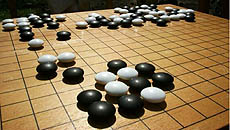Electromagnetism, the simplest force
 |
Much like the game of go, the basic rules of the electromagnetic force are simple, yet they play out in complex ways.
|
Electromagnetism is the training ground for modern physics, both in its historical development and in classrooms today. It is the simplest of the four forces, compared to the nuclear weak force, nuclear strong force and gravitation, but it gives rise to intricately rich patterns. All of the complex phenomena of everyday life, except for gravity and radioactivity, are due to the workings of electromagnetism. It makes chemical bonds, forming the basis of life, gives structure to solid and liquid matter, and makes lightning and aurora borealis twist across the sky.
And yet the fundamental rules of electromagnetism are startlingly simple: Like charges repel and opposite charges attract. If fundamental forces were board games, electromagnetism would be go, in which the rules can be learned in a few minutes but for which the strategy takes a lifetime to master. The other forces are more like chess, with more complicated fundamental interactions. The only problem with this analogy is that electromagnetism took physicists two centuries to learn and has never been mastered.
Electromagnetism was the first of the forces to be understood in a quantum context, in the late 1940s. The key insight was understanding that like charges repel because one emits a virtual photon and the other catches it, as described in the last Nutshell. Analogous to people in rowboats tossing a sack of flour back and forth, the momentum of the exchanged photons is transferred to the charges, pushing them apart.
So how do opposite charges attract? How can one boatman throw a sack of flour to another and have the boats drift toward each other? As it turns out, the quantum nature of the photon is essential. Photons can carry momentum without moving in a straight line between the throw and the catch: They pop from one location to another randomly. When two opposite charges attract, it is as though the sack of flour pops into existence behind the second boatman, pushing him toward the first. Think about that the next time two socks electrically cling in the laundry.
You may have heard of photons as "particles of light." That's true, too. Photons can be found in a virtual state, in which they act as described above, or a real one. Real photons are massless quanta of light, radio, gamma rays and any other frequency of electromagnetic radiation. Virtual photons are sometimes massive, sometimes here, sometimes there, always flitting back and forth between charges to bring them together or push them apart. Moreover, "virtualness" or "realness" is a matter of degree—visible light only approximates a massless train of waves.
The one aspect of electromagnetism that makes it seem simple (in comparison) is the fact that photons themselves do not attract or repel each other; they only affect charged particles. This feature separates electromagnetism from all the other forces. Strong force gluons are a sticky mess of gluons attracting gluons by emitting gluons, weak force dynamics are complicated by self-couplings, and gravity can attract itself in the form of a black hole. But the surprising thing is that the two nuclear forces look a lot like electromagnetism—they follow the same paradigm of virtual particles being tossed back and forth. They differ only in the details of how the pieces interact as they move across the board.
—Jim Pivarski
Want a phrase defined? Have a question? E-mail today@fnal.gov.
 |
The attraction between opposite charges is a bit like two boaters tossing boomerangs, rather than sacks of flour. The photon appears behind the second charged particle, pushing it toward the first. Image courtesy of Dan Claes
|
|